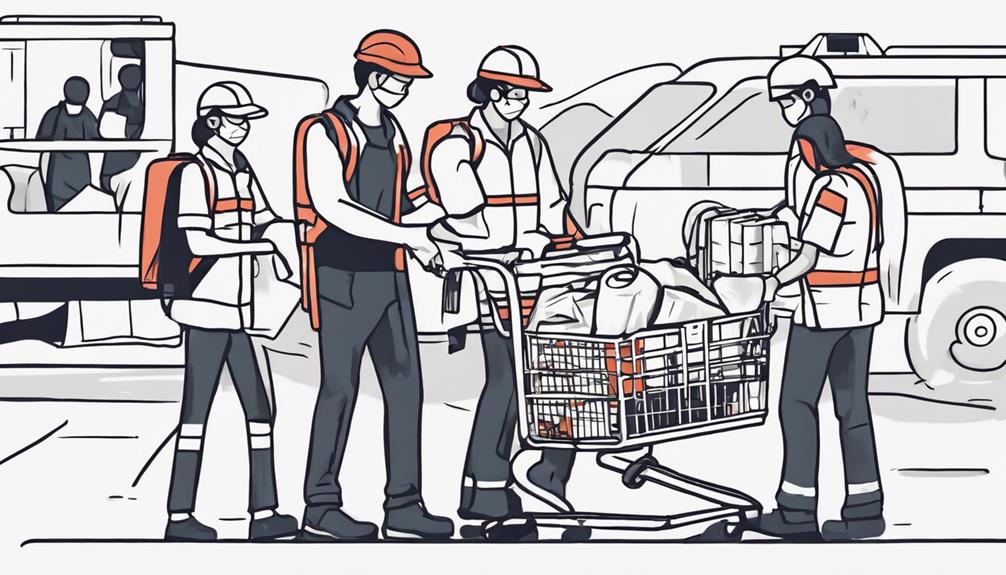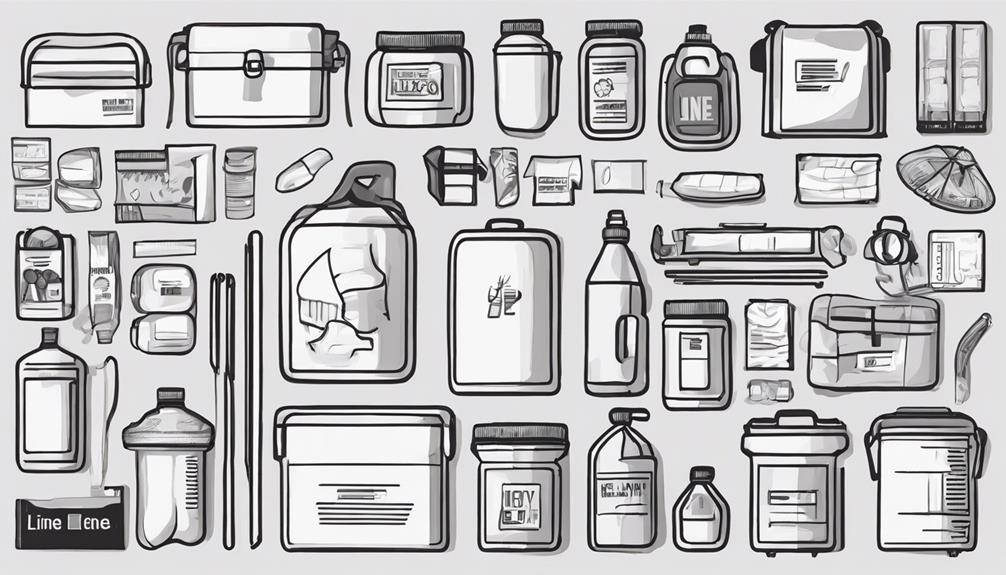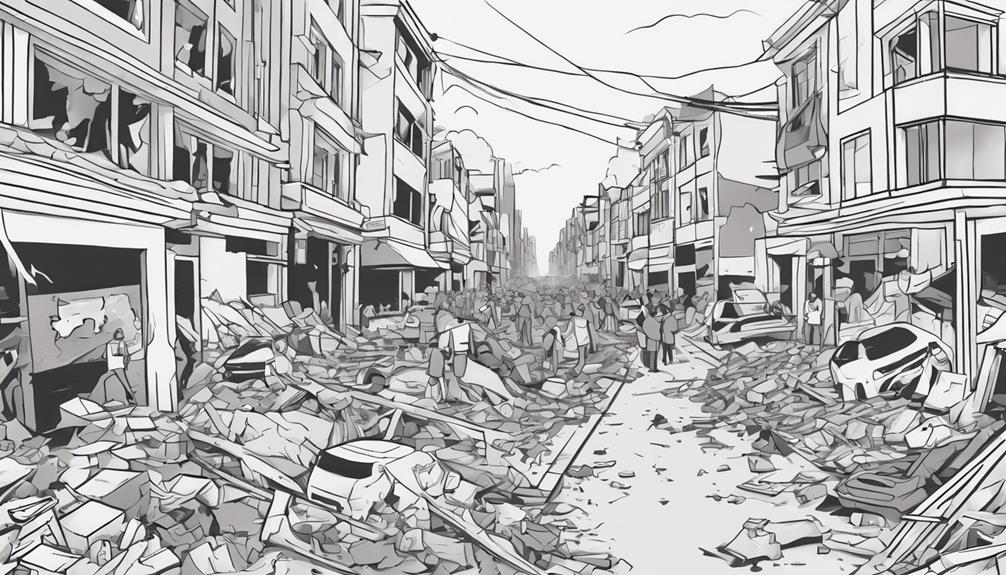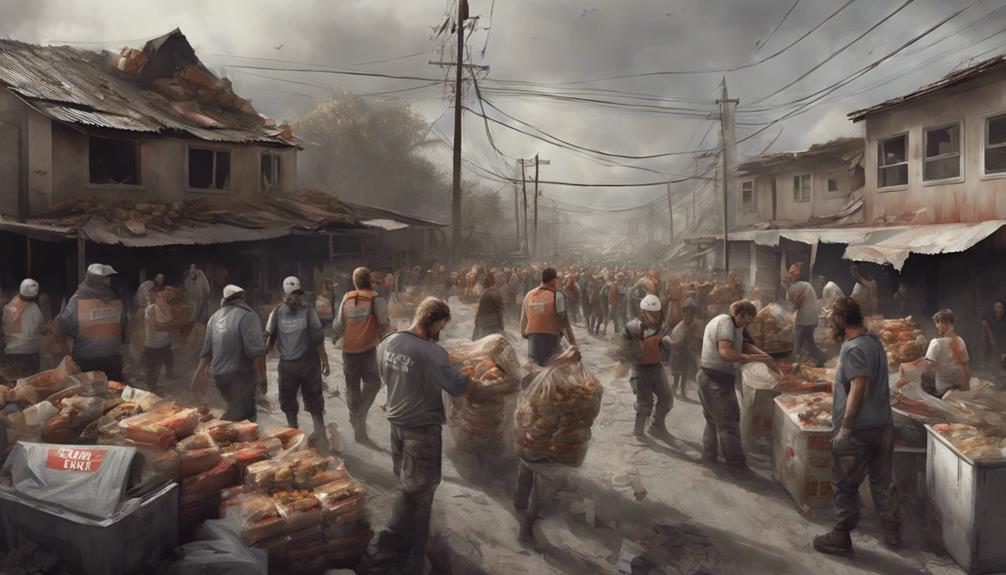In times of crisis, the concept of disaster relief becomes paramount in addressing the immediate and long-term needs of those affected. It involves a strategic deployment of resources and services to mitigate the impact of disasters and provide essential support to communities reeling from devastation. However, the complexity of disaster relief operations extends beyond mere provision of aid. Understanding the intricate web of stakeholders, challenges, and future trends in this field is crucial for effective disaster response. By exploring the multifaceted nature of disaster relief, a deeper comprehension of its significance and evolving dynamics emerges.
Key Takeaways
- Involves swift aid post-catastrophes for impacted individuals and communities
- Provides essential services like shelter, meals, healthcare, and mental health support
- Facilitates recovery, reduces suffering, and saves lives with timely response
- Coordinated efforts by FEMA and various stakeholders ensure effective disaster mitigation
Definition of Disaster Relief

The concept of disaster relief encapsulates the swift provision of aid and support to individuals and communities grappling with the aftermath of natural or man-made catastrophes. In the United States, the Federal Emergency Management Agency (FEMA) plays a crucial role in coordinating disaster relief efforts, working in collaboration with state and local governments to ensure a rapid and effective response. When disasters strike, FEMA provides essential services such as shelter, meals, emergency supplies, healthcare, and mental health support to help those affected recover and rebuild their lives.
Disaster relief operations are essential in responding to the approximately 65,000 disasters that occur each year, with the majority being home fires. These operations aim to offer critical support to individuals and communities in need during times of crisis. Organizations like the Red Cross are major providers of disaster relief, ensuring impartiality and non-discrimination in delivering assistance to all individuals, regardless of nationality, race, or beliefs. Donations and community support are vital in sustaining these relief efforts, allowing organizations to efficiently allocate funds to provide care to those impacted by disasters.
Importance of Disaster Response
Effective disaster response plays a pivotal role in mitigating the impact of catastrophes on individuals and communities, facilitating swift recovery, and reducing overall suffering. When disasters strike, whether natural or man-made, the immediate response is critical in saving lives and addressing the urgent needs of affected populations. Timely disaster response efforts provide essential services such as emergency shelter, food, water, and medical care to those in distress.
Coordination among different agencies and organizations is essential for a well-rounded and efficient disaster response. By working together, these entities can ensure that resources are effectively allocated and that assistance reaches those who need it the most. Proper planning and preparedness before disasters occur are also key components of effective disaster response. Having robust response plans in place can enhance the efficiency of relief efforts and minimize the adverse effects of disasters on communities.
In essence, disaster response is not only about immediate aid but also about laying the foundation for long-term recovery and resilience against future calamities.
Types of Disaster Assistance

During times of disaster, various forms of assistance are provided to individuals and communities in need. Disaster assistance encompasses a wide range of support services aimed at helping those affected by disasters. This aid can include financial assistance to help with recovery costs, emergency shelter for those displaced from their homes, meals to ensure proper nutrition, health services to address medical needs, and mental health support to cope with the emotional toll of the disaster. Relief workers play a crucial role in providing this assistance, responding to emergencies every 8 minutes and managing approximately 65,000 disasters annually. It is noteworthy that 95% of these relief workers are volunteers who selflessly contribute their time and expertise to support those in need during challenging times. The types of disasters responded to vary, with home fires being a significant proportion, showcasing the diverse range of relief efforts required to assist individuals and communities in crisis. Disaster relief operations aim to provide overnight shelter stays, meals, emergency supplies, and various support services to alleviate the hardships faced by those affected by disasters.
Role of Government in Relief Efforts
The role of the government in disaster relief efforts encompasses crucial responsibilities such as determining funding allocation decisions, coordinating aid from various agencies, and ensuring a swift and effective response to disasters. Government agencies collaborate to provide financial assistance, resources, and support to individuals and communities affected by disasters, working towards a comprehensive recovery process. By leveraging programs like disaster declarations under the Robert T. Stafford Act and state-level initiatives, the government plays a pivotal role in facilitating relief efforts and aiding in the rebuilding and recovery of affected areas.
Government's Relief Responsibilities
In disaster relief efforts, the government plays a crucial role by providing emergency financial assistance and coordinating collaborative grants for community-based recovery services. Following a disaster declaration, the government ensures that recovery efforts address the specific needs of communities affected. Different types of disaster declarations, as outlined in the Stafford Act, provide targeted assistance to individuals, households, and governments based on the nature and severity of the disaster. Moreover, the government supports federal disaster response activities and eligible state actions to facilitate a comprehensive recovery process. Additionally, tax relief measures are often implemented to alleviate the financial burden on individuals and businesses impacted by disasters, further emphasizing the government's commitment to aiding in disaster recovery efforts.
Coordination of Aid
Government agencies coordinate aid efforts to ensure efficient and effective response and recovery in disaster-stricken areas. Coordination involves deploying resources, personnel, and funding to areas affected by disasters to provide assistance and support. Collaboration with non-profit organizations, volunteers, and other stakeholders enhances the overall coordination of aid during disaster relief operations. Effective coordination of aid by the government helps streamline response efforts, maximize resources, and support communities in times of crisis. Key entities like FEMA play a critical role in disaster relief by coordinating federal assistance after a disaster declaration, ensuring that resources are promptly and appropriately allocated to support affected regions.
Funding Allocation Decisions
Efficient and strategic allocation of funding is paramount in ensuring the success of disaster relief efforts led by governmental entities. Government agencies base allocation decisions on factors such as the severity of the disaster, the impact on affected areas, and the specific needs of the community. Transparent and accountable processes help ensure effective distribution of funds to address immediate needs and support long-term recovery. Proper allocation maximizes the impact of relief efforts, providing timely assistance to those in need. Resources are allocated to support critical activities like infrastructure repair, financial aid for survivors, and hazard mitigation initiatives. Additionally, disaster tax relief measures and disaster declarations play key roles in shaping government allocation decisions.
| Factors Considered | Importance | Examples |
|---|---|---|
| Severity of Disaster | Determines resource needs | Natural disasters, pandemics |
| Impact on Affected Areas | Identifies critical support | Damage assessment, population affected |
| Specific Community Needs | Tailors assistance | Shelter, medical supplies |
Key Stakeholders in Disaster Relief
Key stakeholders in disaster relief, including prominent organizations like FEMA and the American Red Cross, play integral roles in coordinating and providing assistance during times of crisis. These stakeholders are essential for effective disaster response and recovery.
- Federal Emergency Management Agency (FEMA): FEMA is a crucial stakeholder in disaster relief, responsible for coordinating federal government assistance and resources in response to disasters.
- Local governments: Local and state emergency management agencies are key stakeholders that play a vital role in disaster relief efforts by coordinating response activities, providing resources, and ensuring community safety.
- Volunteer organizations: Volunteer organizations such as the American Red Cross and Team Rubicon are instrumental in disaster relief, offering immediate assistance, shelter, medical aid, and emotional support to affected communities.
These stakeholders work collaboratively to ensure a comprehensive and timely response to disasters, highlighting the importance of coordination and cooperation among various entities in disaster relief efforts.
Challenges in Providing Aid

Amidst the intricate landscape of disaster relief operations, the provision of aid grapples with multifaceted challenges that demand strategic solutions and seamless coordination. One of the primary obstacles faced in providing aid during disasters is the presence of logistical hurdles, which impede the swift and efficient delivery of assistance to affected areas. Limited resources and funding further exacerbate these challenges, often hindering the scale and effectiveness of relief efforts. Coordination among various organizations and agencies involved in disaster response can also be complex, necessitating clear communication channels and unified strategies to ensure a cohesive approach.
Additionally, cultural and language barriers present significant challenges in delivering aid to diverse populations, requiring sensitivity and adaptability from relief workers. Moreover, addressing the mental health and emotional well-being of survivors emerges as a critical concern in disaster relief efforts, underscoring the importance of integrating psychological support services into relief operations. Collaborative efforts involving stakeholders such as the Emergency Management Agency (FEMA) are essential in overcoming these challenges and enhancing the overall efficacy of disaster relief initiatives.
Future of Disaster Relief Efforts
In the realm of disaster relief, the evolving landscape necessitates a proactive approach towards enhancing response strategies and preparedness measures. The future of disaster relief efforts is being shaped by various factors, including technological advancements, climate change impacts, and collaborative initiatives.
- Technological Advancements: Technologies such as AI, drones, and data analytics are revolutionizing disaster response capabilities, enabling quicker and more effective interventions during natural disasters.
- Climate Change Challenges: The increasing frequency and intensity of natural disasters due to climate change pose significant challenges to traditional relief efforts, requiring innovative solutions and adaptive strategies.
- Community Resilience Building: Focusing on community resilience through education, early warning systems, and infrastructure development is crucial for enhancing preparedness and reducing the impact of disasters on vulnerable populations.
As we move forward, exploring innovative funding mechanisms, enhancing collaborations between stakeholders, and prioritizing community resilience will be key in ensuring effective disaster relief efforts in the face of evolving challenges.
Frequently Asked Questions
What Is the Meaning of Disaster Relief?
Emergency response, humanitarian aid, and crisis management are essential components of disaster relief. It encompasses the provision of immediate assistance such as shelter, food, water, medical care, and mental health services to individuals and communities affected by natural disasters or emergencies. Organizations like the Red Cross play a crucial role in coordinating and delivering resources to support those in need during crises. Disaster relief aims to address urgent needs, restore essential services, and facilitate the recovery and rebuilding of impacted areas.
What Are the Three Types of Disaster Relief?
In the realm of emergency response and humanitarian aid, three pivotal types of disaster relief emerge: emergency declarations, major disaster declarations, and public assistance declarations. Each type plays a crucial role in supporting recovery efforts, rebuilding communities, and enhancing disaster preparedness and risk mitigation strategies. Comparable to essential tools in a well-stocked toolkit, these types of relief work in unison under the Robert T. Stafford Act to ensure effective coordination in times of crisis.
What Is Disaster Relief From the Irs?
IRS assistance provides relief measures to individuals and businesses affected by disasters. This relief may include extensions for tax filing deadlines, waivers for penalties, and opportunities for claiming disaster-related losses. Eligibility criteria may vary based on the specific disaster and its impact. It is essential for taxpayers to understand the tax implications of receiving such assistance and to follow IRS guidelines for availing themselves of disaster relief provisions.
What Are the Benefits of Disaster Relief?
Emergency response in disaster relief provides essential humanitarian aid, including shelter, meals, and support services to those affected by disasters. This assistance extends beyond immediate needs, fostering community support and aiding in recovery efforts. The benefits of disaster relief are evident in its ability to provide critical assistance swiftly and efficiently, ensuring the well-being and safety of individuals impacted by emergencies.
Conclusion
In the intricate tapestry of disaster relief, various threads come together to weave a safety net for those in need. The orchestrated symphony of government agencies, non-profit organizations, and volunteers plays a vital role in providing swift and effective aid to affected communities. Despite the challenges that may arise, the future of disaster relief efforts holds promise for continued innovation and improvement in responding to crises with compassion and efficiency.
